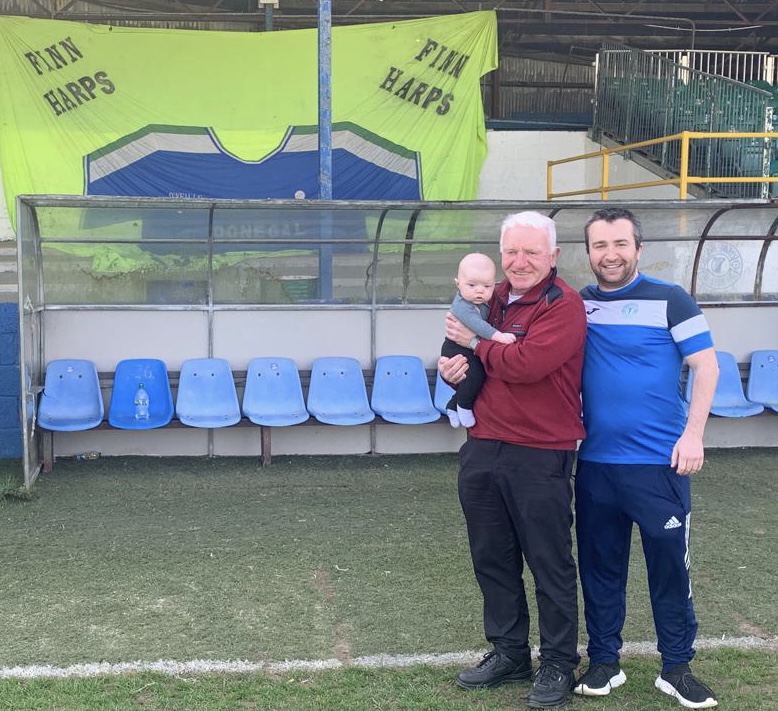
An image of the planned new stadium for Finn Harps
Fourteen years ago this month the sod was turned for the new Finn Harps stadium in Stranorlar. After countless false dawns, there are many who doubt if the new facility will ever materialise. But Paul McLoone, one of the driving figures behind the project, is adamant that it will happen, and that Harps will be playing in the Donegal Community Stadium by 2024. He gave an update on the stadium project to Chris Ashmore.
Last March, as he was lying in a hospital bed, Paul McLoone started to think about alternative plans for Finn Harps stadium. With construction costs soaring, it was time to take stock of where things were at. Little progress was being made.
Fast forward to the present day and a whole new scenario has emerged. Rather than looking at a stadium costing €11.5m - a radical new approach means that the cost could end up being nearer €8 million.
The Harps stadium committee has looked in depth at alternatives, including modular options.
McLoone, who had to step aside as a director of the club in 2021, due to health reasons, has again taken up the mantle to spearhead the project in order to bring this long ongoing saga to a satisfactory conclusion.
“You will have read in recent days that there will have to be a total rethink on the Dalymount Park project in Dublin as prices are spiralling out of control with regard to their original plans. I was lying in a hospital bed in March last year when it dawned on me that we needed an alternative plan for our stadium as the radio stations were saturated with coverage of the impact of Brexit etc., especially on the construction sector.
“As a result, our stadium sub group looked at other options for construction with bottom line budgets being the determining factor. We looked at stadia in Europe and the UK which used steel structures as the main component of the build. We opened discussions with the Department of Transport, Tourism and Sport, Donegal County Council and the FAI and because of this proactive approach we are now at a very advanced stage with regard to receiving approval for an alternative build,” he explained.
The revised proposals will see the overall spectator capacity virtually unchanged at 6,130.
“There will be 2,800 standing on covered terracing (1,400 behind each goal) with 3,300 seated along both sidelines which comprises 1,930 in the West Stand (which is partly built) and 1,400 in the East Stand,” he said.
“I have put a lot of time and effort into the project over the past four months to the extent that we are now very hopeful that the Government will approve the recommencement of work in the near future. It is not over the line yet but we are optimistic that we can at long last deliver a stadium that all of the county can be proud of,” he said.
And he revealed: “Since January of this year we have gone directly to the market place to ascertain up to date costs and we are in direct discussions with a number of suppliers about building the different elements of the stadium. It will take approximately nine months to construct and when we lay the pitch it will take 10 months to mature. We have not got a definitive start date as yet but we must lay the pitch at the latest in September 2023 which means all the building work will have to be completed by that date.”
He is confident that construction work will begin before the end of this year.
Grants will equate to around 70% of the total cost of developing the new stadium, which will be known as the Donegal Community Stadium. The other 30% will come from loans, fundraising, and other initiatives.
Discussions with financial institutions have been taking place.
He confirmed that the club will be embarking on major fundraising efforts in the near future.
But getting that matching funding will be a massive challenge.
And, until there is activity on site, the sceptics will remain.
Indeed, two years ago he acknowledged that what has already been built on the main stand side “will soon be not fit for purpose”.
Nevertheless, the push is on once again.
McLoone’s enthusiasm cannot be doubted. The former CEO with North-West Tourism has an in-depth knowledge of dealing with the intricacies of government departments and funding applications.
Planning permission for a new stadium was first sought in 2005. Few thought that 17 years on we would still be waiting. Some real progress is desperately needed soon. The chinks of light in the past have long faded.

Above: Paul McLoone with his son Shane and grandson Conor at Finn Park
Finn Park has long been one of the most rundown stadiums in the league, and it is clearly inadequate with only 300 seats and limited facilities. It falls far short of what is required for top-flight soccer, but the club has been given a rolling derogation from the FAI for being in the process of developing its new ground.
But something has to give. This is a crucial time for the club off the park.
Subscribe or register today to discover more from DonegalLive.ie
Buy the e-paper of the Donegal Democrat, Donegal People's Press, Donegal Post and Inish Times here for instant access to Donegal's premier news titles.
Keep up with the latest news from Donegal with our daily newsletter featuring the most important stories of the day delivered to your inbox every evening at 5pm.